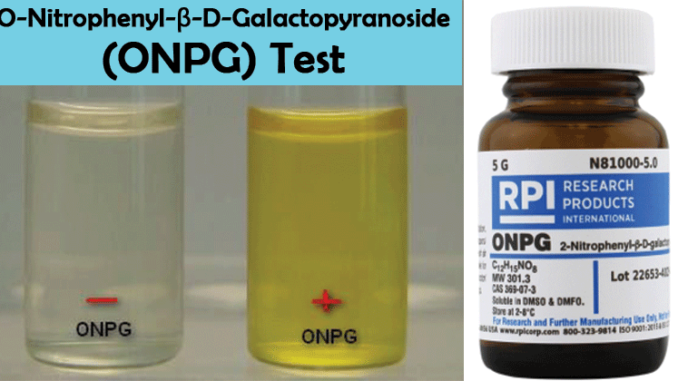
Principle of ONPG test:
- Lactose is a disaccharide of glucose and galactose which is connected by a β-galactoside bond.
- Lactose fermenting bacteria consist of both the permease and beta-galactosidase enzymes that are responsible for acid production during lactose fermentation.
- Permease permits the lactose to enter into the bacterial cell wall.
- Then, beta-galactosidase breaks down the lactose into glucose and galactose.
- But in some organisms, permease is absent and hence appear as late or non-lactose fermenters.
- O-Nitrophenyl-β-D-galactopyranoside (ONPG) resembles to lactose in structure, except that glucose is substituted by orthonitrophenyl group.
- In contrast to lactose, the substrate O-nitrophenyl-beta-D galactopyranoside (ONPG) can penetrate the bacterial cell wall even in absence of permease.
- ONPG test is a very sensitive test for lactose-fermentation.
- In this test, O-Nitrophenyl-β-D-galactopyranoside (ONPG) (artificial in nature) acts as a substrate for beta-galactosidase to ascertain the specific enzyme activity that serves in the identification and differentiation of organisms.
- If the organism consists of beta-galactosidase, then it will hydrolyse ONPG to yield galactose and o-nitrophenol.
- The positive test is confirmed by the yellow colour, which is given by ortho-nitrophenol.
- A positive ONPG test is mainly focused on providing the rapid identification of delayed lactose fermentation.
Requirements:
- Sodium phosphate buffer, 1 M, pH 7.0
- O-Nitrophenyl-β-D-galactopyranoside (ONPG), 0.75 M
- Physiologic saline
- Toluene
- ONPG broth: Ingredients per 1000 mL
- Na2HPO4 —————- (9.46 g)
- phenylalanine ——— (4 g)
- ONPG ———————– (2 g)
- KH2PO4 ——————–(0.907 g)
- pH 8.0
- ONPG disk:
- ONPG Differentiation Disk is made by impregnating controlled concentrations of ONPG onto a 0.25 inch diameter filter paper disk.
Procedure of ONPG test:
- For ONPG disk method:
- Keep an ONPG disk into a sterile tube.
- Add 0.2 mL saline to it.
- Use a loopful of test isolate to heavily inoculate the tube.
- Incubate at 35-37°C for up to 4 hours.
- Observe for colour change of the disk.
- For broth method:
- Keep the test medium to room temperature.
- Use heavy inoculum from a pure 18-24 hr culture to inoculate the test medium.
- Incubate aerobically, at 35- 37ºC, with caps loosened.
- Observe for a yellow colour development at 1 hour.
- If no colour change is observed in the tube even after 1 hour of incubation, continue incubation for up to 24 hours.
Results interpretations:
- Positive result:
- The positive test is indicated by the yellow colour of ortho-nitrophenol resulted by the hydrolysis of ONPG.
- Negative result:
- The negative test is suggested by no change in colour, that means the absence of enzyme.
Limitations of ONPG test:
- Further biochemical, molecular, immunological, or mass spectrometry testing on colonies from pure culture is advised for complete identification.
- Cultures which naturally yield yellow colour cannot be tested in this media.
- Inoculation of test organism should be done only from lactose- containing medium.
